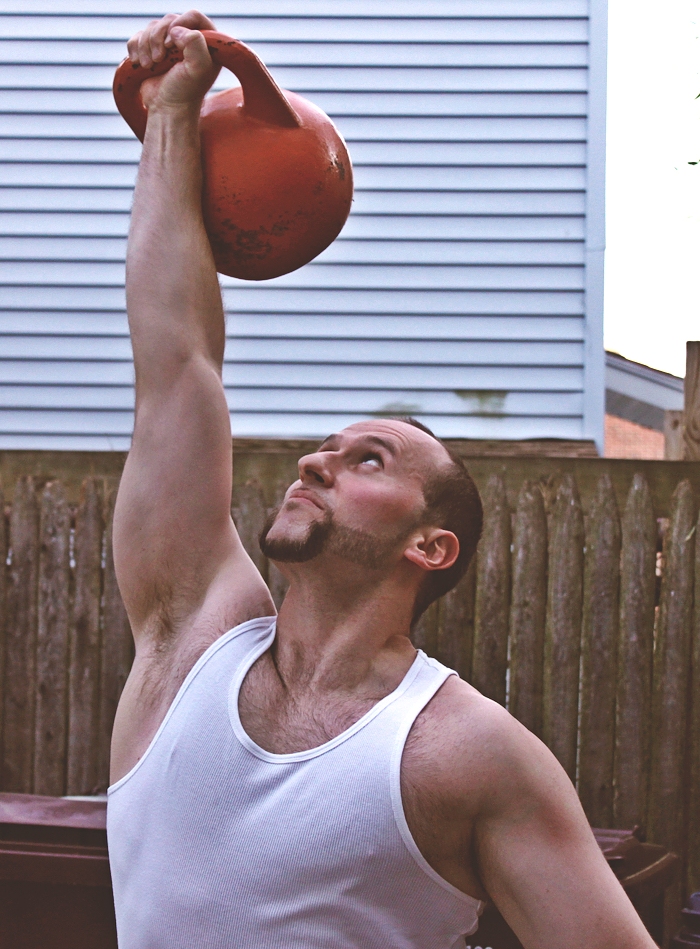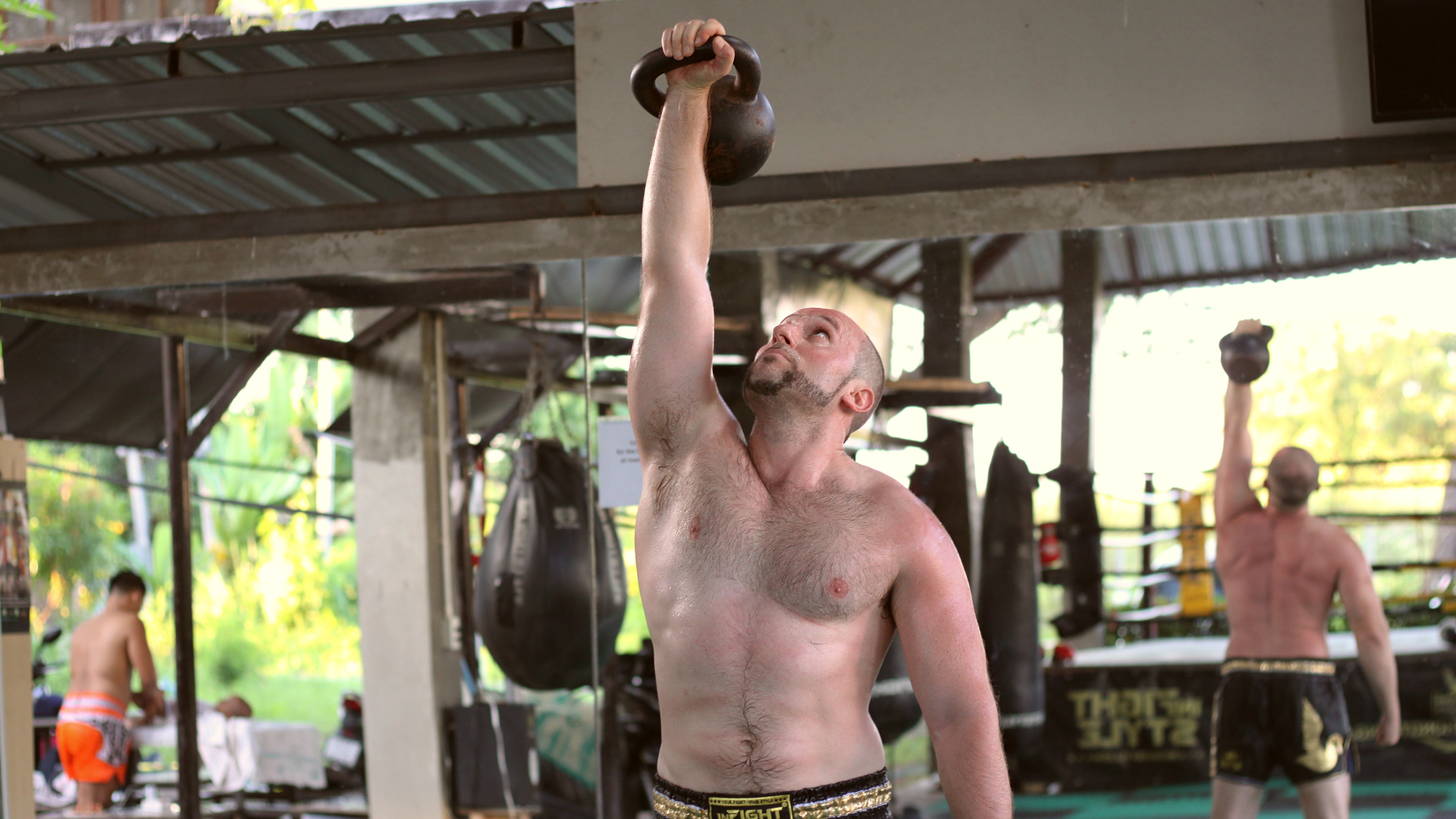Are you curious about kettlebell training but don’t know where to start as a complete beginner?
What Is Kettlebell Training?
Kettlebells as a piece of equipment have their origins in early 18th century Russia. Back then, when they were still only known by their original Russian word - girya - people did not use them to get in top physical shape. Rather, they were used as a counterweight in local markets to measure the quantity of product being sold.
Over time, when activity in the market was slow, some vendors began swinging and pressing the bells as a way to pass time and to show off their strength among each other. Eventually, these movements became popular enough that it evolved into its own style fitness training.
However, despite its popularity in Russia and some former East Bloc countries, it was relatively unknown in the West. Then, in the year 1998, a former Soviet SPETSNAZ fitness instructor named Pavel Tsatouline introduced them in the United States. In true capitalist fashion, they were commodified and an entire new line of fitness business based around kettlebells was born.
Today you will rarely go to a gym that doesn’t have at least a few kettlebells available for use. There are also kettlebell certifications and courses you can take, and websites with kettlebell tutorials to improve your knowledge. Over the course of the past 20+ years, they’ve gone from a Soviet secret to a worldwide fitness staple.
The reason is simple - they are fun to workout with and they work really well for a wide variety of fitness goals.
Table of Contents
- What Are the Advantages of Kettlebell Training?
- What Are the Disadvantages of Kettlebell Training?
- Should I Try Kettlebells?
- How to Start Kettlebell Training from Zero
What Are the Advantages of Kettlebell Training?
Kettlebell training offers a long list of benefits. Let’s go over some of the main ones below.
Increase Grip Strength
Unlike barbells and dumbbells which are neatly balanced on either side and sit in the center of your palms, the shape of the kettlebell has an offset center of gravity.
In order to hold the bell in place, the kettlebell user must maintain a continuous forward flexion at the wrist - otherwise the weight would just pull the person’s hand backward and create an awkward, even potentially dangerous hand position.
As a result, a kettlebell practitioner may do something like kettlebell squats - which are clearly not an exercise meant for improving grip strength - but reap the side benefit of improved grip strength anyway.
It’s similar to the way that most calisthenics exercises work the core, even without having to directly target the core.

Shred Fat
Once you get comfortable with performing some of the staple kettlebell exercises like swings, cleans, presses, snatches, and Turkish get-ups, you can begin working on kettlebell style circuits, which are often done AMRAP (as many reps as possible) style for time.
They are intense, get your heart rate going, your sweat dripping, and they kick your metabolism onto high-gear, fat burning mode.
Improve Your Cardio Even If You Hate Doing Cardio
Similar to the way that kettlebells improve your grip strength without having to directly do grip-specific exercises (because who really enjoys doing wrist curls?), kettlebells also increase your cardiovascular endurance without having to do traditional cardio workouts like running, riding an elliptical or cycling.
There is absolutely nothing wrong with any of those, but if you happen to be someone who doesn’t necessarily enjoy them or if you simply want to switch it up, then kettlebell training is a more than adequate substitute.
Real-World Cardio Benefits
A really close friend of mine loves kettlebell training and does it frequently. He rarely ever runs. However, he’s occasionally gone running with me and for a non-runner he can definitely hold his own.
The reason is due to lots and lots of kettlebell circuits that incorporate kettlebell swings.
Strengthen the Often Neglected Posterior Chain
A vast library of the exercises that exist in the kettlebell arsenal rely on generating force by way of the hip hinge. Kettlebell swings are the obvious one, but even seemingly upper body exercises like the kettlebell clean and press are fueled by the hips.
The hips themselves are joints, not muscles though, so that means that something else must be fueling the movement happening in those hips. That something else is the many muscles in your posterior chain (the back side of your body). These include your glutes (butt), hamstrings, and your lower back.
Who Benefits Most
For young males who lift weights and are of a certain age, the posterior chain is often underdeveloped en lieu of spending excessive time focusing on their mighty pecs and their beautiful biceps. However, this demographic isn’t the only one who can benefit from a stronger posterior chain. It’s good for everyone.
Increase Mobility, Range of Motion, and Joint Stability
While there are certain kettlebell exercises that closely resemble or borrow from their barbell and dumbbell counterparts, many of the core kettlebell movements train movement patterns with ballistic force through full ranges of motion.
The Ballistic Training Effect
Think of kettlebell movements as controlled, dynamic stretching under load. When you perform exercises like swings or snatches, you’re repeatedly moving joints through their full range of motion while under tension and at speed.

This type of training promotes several adaptations: the muscles learn to generate force at end ranges, connective tissues adapt to handle dynamic loads, and your nervous system becomes more comfortable controlling movement at these ranges.
Over time, this leads to improved mobility and joint stability.
Your body adapts by increasing both the range through which you can move and your strength and control within that range.
The key is progressive overload and proper form.
When done intelligently with gradually increasing intensity, this type of training can significantly improve your functional range of motion while building strength throughout that range. This is excellent for long-term injury prevention.
However, like any training method, it needs to be approached sensibly. Too much too soon, or poor technique, can have the opposite effect.
Develop Real-World Strength and Functional Application
Functional strength has been one of the buzz words in fitness for a long time now. In simplistic terms it just means developing strength in random planes of motion and with weight that’s not always evenly balanced.
Although traditional bodybuilding style weightlifting exercises can develop muscle and strength, the movements themselves are usually in a very particular range of motion that is typically done in only one plane - either front to back, up and down, and vice versa (sagittal plane), or side to side to either the left or right (frontal), or in a rotational, corkscrew pattern (transverse).
Real-Life Movement Patterns
Now contrast that with real life examples of lifting and carrying randomly shaped objects with uneven weight distribution like tables, chairs, or bags. A person can develop big muscles and good strength in a very particular movement pattern that matches that of the fixed plane of motion exercises that he or she does, but what happens if in a real life scenario that person has to pick up something that’s heavy and awkwardly shaped?
What if they have to carry it up a flight of stairs and adjust its position to get around stair knobs or wall corners?
His or her CNS might not be comfortable or familiar with those ranges of motion or those movements patterns. If the velocity of the movement and the weight of the object are both strong enough then the seemingly strong, muscular person can get injured.
Kettlebell Advantage
In comparison, an individual who regularly trains with kettlebells will have a CNS that is well accustomed to shifting an object with uneven weight distribution, quickly moving through space and sometimes shifting direction. The ability to control that type of random movement with that type of random object is what functional strength is and why kettlebells help you develop it.
A Realistic Perspective
Having said that, I think that sometimes the importance of functional strength is overstated. Unless you are a professional furniture mover, a construction worker or do something else that requires you to regularly lift heavy objects with uneven weight distribution, then your functional strength will only come in handy so often.
In the very long run when you become elderly it will also come into play if you’ve developed it in your younger years, but for the most part, it’s not as crucial as it’s sometimes made out to be.
Keep in mind, I’m a huge fan of it and I mostly train using so-called functional exercises so I’m not talking bad about it or dismissing it. However, I’m not going to tell you that it has some insane amount of real world transfer to my life on a daily basis. My life would not be drastically different if I just did bodybuilding isolation exercises only. I just happen to find functional workouts, including kettlebells, more fun and personally rewarding.
Finding This Content Useful?
Sign up to get notified whenever a new blog post or tutorial gets published.
Thanks for subscribing!
You'll be notified when new content is published.
Check your email for a confirmation message.
What Are the Disadvantages of Kettlebell Training?
Not Very Beginner-Friendly
Compared to other fitness modalities, kettlebells have perhaps the steepest beginner learning curve. Even some of the most basic kettlebell exercises require a degree of comfort with the proper technique to execute them.
This means that if you’re trying to get started quickly and you’re eager to see results in terms of strength, physique, and other common fitness pursuits, you will have to set those aside for learning proper technique first.
Lack of Upper Body Horizontal Pushing Movements
Kettlebells have some really cool exercises that are unique to only kettlebells and that challenge the body in ways that can’t be replicated with barbells and dumbbells. The flip side to that is that due to their unique shape, it can be awkward to use them for certain classic weightlifting staples, particularly ones that require pushing horizontally.
Think about it - have you ever seen someone bench press with kettlebells? Maybe you have, but it’s not exactly the ideal tool for that exercise.
Can Be Expensive to Start
Another disadvantage of kettlebells is the cost. Unlike barbells and certain types of dumbbells that allow you to adjust the weight, kettlebells are one solid piece of metal. In a practical sense, this means that if you want to train your whole body using different kettlebell exercises, you will need to buy at least 2 pairs of kettlebells weighing different amounts, and ideally 3 or more pairs.
There are certain ways you can work around this if you understand how to manipulate training variables, but it’s not the most ideal way to go about it. Of course in comparison to an ongoing monthly gym membership fee, a solid kettlebell investment will last you a long time so in that sense it’s not too bad.
However, the up front cost can still be discouraging for some people - especially beginners who are still dabbling and trying to figure out which fitness style is best for them. The last thing you want is to drop $200 - $300 on something that you’ll realize is not for you.
Should I Try Kettlebells?
Who Should Consider Kettlebells
If you’re not in a huge rush to see results in the way of aesthetics or strength and you have some patience to learn the proper execution of various kettlebell exercises, then absolutely give kettlebell training a go. Kettlebells are an excellent and fun training tool that have lots of benefits. Certain kettlebell exercises challenge your body in truly unique ways.
I mean what else can replicate a kettlebell shoulder press where the bell part of the kettlebell is pointing upward and you have to press it by the handle of the bell that’s underneath? There’s just nothing like it and it feels great.
Performance Benefits for Athletes
The other nice thing about kettlebell training is that if you are an athlete playing certain sports or you engage in other non-fitness physical activities, then incorporating it into your routine may improve your performance in those other disciplines. For example, if you get really good at kettlebell swings, your running endurance will improve even if you never actually run.
Now imagine if you do both! Your running game may be elevated to new heights compared to if you only focused on running by itself.
Cross-Training Appeal
Interestingly, I’ve also noticed that kettlebells tend to attract fitness enthusiasts that specialize in other training styles more so than calisthenics or weightlifting do. For example, there are people who are hardcore weightlifters who have a sense of superiority about lifting weights and will never do calisthenics. Along the same lines there are some calisthenics practitioners who swear by bodyweight exercise and will never lift weights.
However, I’ve found that those personality types from both camps may sometimes give kettlebells a try. Why that is I’m not sure, but it is an interesting phenomena that I’ve observed over the years. It might just be because they are something different and they’re fun.
So if you have a bit of patience in you, and you too want to try something different and fun, then give kettlebell training a shot. Just remember to proceed slowly and carefully.
How to Start Kettlebell Training from Zero
As was mentioned in the disadvantages of kettlebells section earlier, kettlebells have a very steep learning curve.
The practical takeaway from this is that you should start kettlebell training with a degree of caution and with patience.
If you are an absolute beginner to exercise then to be perfectly frank, I would not recommend starting with kettlebells at all.
You are much better off exploring the worlds of calisthenics, weightlifting or yoga.
However, if you have at least some fitness experience under your belt or you’re just really attracted to the idea of training with kettlebells for some reason, then my suggestion is to start with the following two foundational movements:
a) Single Arm Kettlebell Clean
b) Double Arm Kettlebell Hip Hinge to Kettlebell Swing

Since you would be primarily focused on technique at the beginning, I would also suggest to complement your kettlebell training with some calisthenics or weightlifting after your kettlebell skills practice.
Recommended Training Frequency
I recommend training at least 4 days per week, but no less than 3, although feel free to practice the two kettlebell skills even on your non-training days. Just make sure to take at least one full rest day per week or if you’re really gung-ho about training then you can substitute an active recovery day for the rest day.
This means you would do something that elevates your heart rate but not resistance training. For example swimming, light running or walking would qualify as active recovery.
Sample 4-Day Training Split
If you decide to train 4 days per week, then a possible training split might look like the following:
DAY 1: Work on kettlebell clean technique for 20-30 minutes. Followed by upper body pushing movements using either weights or calisthenics.
DAY 2: Work on kettlebell swing technique for 20-30 minutes. Followed by a calisthenics leg workout and a mobility routine.
DAY 3: Work on kettlebell clean technique for 20-30 minutes. Followed by upper body pulling movements using either weights or calisthenics.
DAY 4: Repeat the second day.
3-Day Alternative
If you can only do 3 days per week, then you can drop the fourth day and work on both swings and cleans in the skills practice portion of day three.
If you need help with this, you’re welcome to email me.
